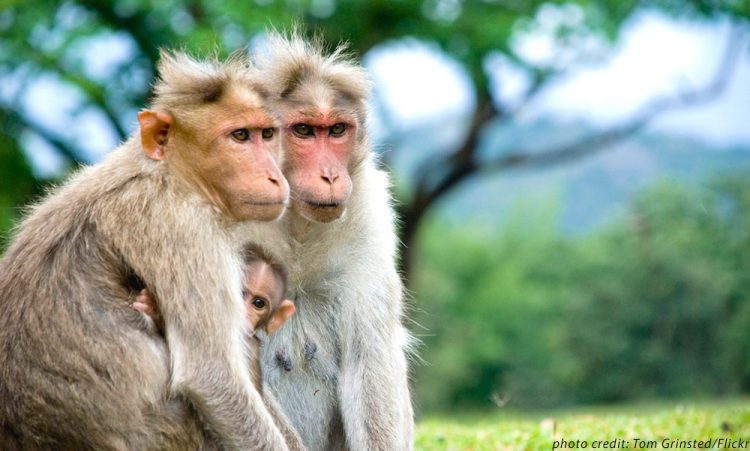‘Red Effect’ sparks interest in female monkeys

“Previous research shows that the color red in a mating context makes people more attractive, and in the fighting context makes people seem more threatening and angry,” explained Benjamin Y. Hayden, a coauthor of the study and professor in brain and cognitive sciences at the University of Rochester.
Hayden, whose research often involves primates, and Andrew J. Elliot, a professor of psychology at Rochester who has published several articles on humans and the red effect and coauthor of the study, sought to uncover what causes humans’ response to the color. Is it triggered simply by repeated cultural exposures, or is there a biological basis that may help explain why the color tends to amplify human emotions?
As Hayden put it, “is this just because every year on Valentine’s Day we see these red things everywhere and it creates a link for us between the color red and romance, or is it really a fundamental thing rooted in our biology?”
One way to test for biological influence would be to assess reactions in individuals who have not been conditioned to associate the color red with romance, Hayden said. “What if we could test this in someone who is not even human, but was exposed to a lot of the same evolutionary pressures? Well, that would be a monkey,” he said. “So, we conducted experiments to see if monkeys would have similar biases as humans, and in a nutshell the answer is, yes, it seems like they do.”
The new study, which appears in the journal Evolution and Human Behavior, involved rhesus monkeys (Macaca mulatta) from a free-ranging population of approximately 1000 residing at the Cayo Santiago field site in Puerto Rico. The animals live in naturally formed social groups and are habituated to human observation.
The researchers conducted two trials that measured the amount of time the primates looked at black and white images of the hindquarters of adult monkeys. The stimuli, which included images of both sexes, were surrounded by an “extraneous” color, framed by either red or blue. The researchers also used an image of a common shell found on the island as a control data point.
Hayden noted that a standard measure to gauge interest in those who don’t have language—primates or babies, for example—is by how long they look at a given object. The longer the gaze indicates a greater amount of interest.
In the first trial, the researchers displayed sequential images of male hindquarters surrounded—in random order—by frames of red or blue, to adult monkeys of both sexes. They were also presented with the shell image.
The researchers found a significant female bias toward the images of male hindquarters, but only when a red frame surrounded the image. “To our knowledge,” the researchers said, “this is the first demonstration of an extraneous color effect in non-human primates.”
In a second trial, the researchers displayed images of female hindquarters surrounded, again by either a red or blue frame. Female monkeys did not show a preference for other female hindquarters, regardless of the color of the surrounding frame.
But, surprising to the researchers, male monkeys did not show a preference for the female hindquarters, either, even when surrounded by the color red.
The researchers say additional work is needed to understand why males did not respond to the extraneous colors. One possibility is that the reproductive state of females is reflected in facial color changes rather than changes in the hindquarters. Images of females, which were restricted to the hindquarter region, may have been too limited to elicit male responses.
That female rhesus monkeys’ interest in images of the opposite sex appears to be influenced by extraneous color suggests that the “red effect” is not unique to humans. Instead, the researchers argued, it appears to be supported by an “evolved biological mechanism.”
Neither males nor females displayed a bias toward the shell image regardless of the color of its frame.
Kelly D. Hughes, a doctoral candidate at the University of Rochester, was lead author of the study. James P. Higham, an assistant professor of anthropology at New York University, and William L. Allen, a post-doctoral fellow in anthropology at the University of Hull, are coauthors.
The Sloan Foundation, NIDA, and two Reach fellowships from the University of Rochester to undergraduate research assistants supported the work. The population of rhesus monkeys at Cayo Santiago is currently supported by the National Center for Research Resources, the Office of Research Infrastructure Programs of the National Institute of Health, and the Medical Science Campus of the University of Puerto Rico.
Monique Patenaude
Media Contact
All latest news from the category: Life Sciences and Chemistry
Articles and reports from the Life Sciences and chemistry area deal with applied and basic research into modern biology, chemistry and human medicine.
Valuable information can be found on a range of life sciences fields including bacteriology, biochemistry, bionics, bioinformatics, biophysics, biotechnology, genetics, geobotany, human biology, marine biology, microbiology, molecular biology, cellular biology, zoology, bioinorganic chemistry, microchemistry and environmental chemistry.
Newest articles

High-energy-density aqueous battery based on halogen multi-electron transfer
Traditional non-aqueous lithium-ion batteries have a high energy density, but their safety is compromised due to the flammable organic electrolytes they utilize. Aqueous batteries use water as the solvent for…

First-ever combined heart pump and pig kidney transplant
…gives new hope to patient with terminal illness. Surgeons at NYU Langone Health performed the first-ever combined mechanical heart pump and gene-edited pig kidney transplant surgery in a 54-year-old woman…

Biophysics: Testing how well biomarkers work
LMU researchers have developed a method to determine how reliably target proteins can be labeled using super-resolution fluorescence microscopy. Modern microscopy techniques make it possible to examine the inner workings…





















